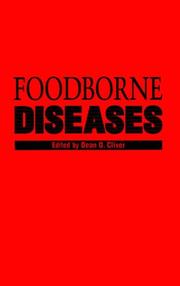| Listing 1 - 10 of 446 | << page >> |
Sort by
|
Book
Year: 2017 Publisher: London : Academic Press,
Abstract | Keywords | Export | Availability | Bookmark
 Loading...
Loading...Choose an application
- Reference Manager
- EndNote
- RefWorks (Direct export to RefWorks)
Book
Year: 2004 Publisher: Copenhagen : Nordic Council of Ministers,
Abstract | Keywords | Export | Availability | Bookmark
 Loading...
Loading...Choose an application
- Reference Manager
- EndNote
- RefWorks (Direct export to RefWorks)
Case-control studies are important tools in modern epidemiological investigations of communicable disease outbreaks. The emerging pathogen, toxin producing Escherichia coli, has caused great awareness due to its potential to cause severe and even fatal illness. To be able to take action against the spread of toxin producing E. coil, a Nordic workshop was organized. This report summarizes the lectures given during the workshop and discussions. It also includes two examples of how a questionnaire could be designed.
Book
Year: 1962 Publisher: London :
Abstract | Keywords | Export | Availability | Bookmark
 Loading...
Loading...Choose an application
- Reference Manager
- EndNote
- RefWorks (Direct export to RefWorks)
Book
Year: 2017 Publisher: London : Academic Press,
Abstract | Keywords | Export | Availability | Bookmark
 Loading...
Loading...Choose an application
- Reference Manager
- EndNote
- RefWorks (Direct export to RefWorks)
Book
ISBN: 1474203159 184946961X 9781849469616 9781474203159 9781849469623 1849469628 9781849466738 1849466734 1849469628 Year: 2015 Publisher: Oxford
Abstract | Keywords | Export | Availability | Bookmark
 Loading...
Loading...Choose an application
- Reference Manager
- EndNote
- RefWorks (Direct export to RefWorks)
"When faced with tackling food-borne illness regulators have a number of competing goals. They must investigate in order to discover the source of the illness. Once the source is identified they must take action to prevent further cases of illness occurring. Finally, once the illness is under control, they may wish to take enforcement action against those responsible. Regulating Food-Borne Illness uses interviews and documentary analysis to examine the actions of regulators and considers how they balance these three tasks. Central to the regulators role is the collection of information. Without information about the source, control or enforcement action cannot be taken. Investigation must therefore take place to produce the necessary information. Utilising theoretical frameworks drawn from regulation and biosecurity, Regulating Food-Borne Illness shows that control is prioritised, and that investigatory steps are chosen in order to ensure that the information necessary for control, rather than enforcement, is collected. This has the effect of reducing the possibility that enforcement action can be taken. The difficulty of evidence gathering and case-building in food-borne illness cases is exposed, and the author considers the methods aimed at reducing the difficulty of bringing successful enforcement action."--Bloomsbury Publishing.
Book
Year: 2010 Publisher: [Washington, D.C.] : U.S. Dept. of Agriculture, Economic Research Service,
Abstract | Keywords | Export | Availability | Bookmark
 Loading...
Loading...Choose an application
- Reference Manager
- EndNote
- RefWorks (Direct export to RefWorks)

ISBN: 012176558X Year: 1990 Publisher: San Diego ; London : Academic Press,
Abstract | Keywords | Export | Availability | Bookmark
 Loading...
Loading...Choose an application
- Reference Manager
- EndNote
- RefWorks (Direct export to RefWorks)
Book
Year: 2021 Publisher: [Washington, D.C.] : U. S. Department of Agriculture, Economic Research Service,
Abstract | Keywords | Export | Availability | Bookmark
 Loading...
Loading...Choose an application
- Reference Manager
- EndNote
- RefWorks (Direct export to RefWorks)
Book
Year: 2020 Publisher: London, England : IntechOpen,
Abstract | Keywords | Export | Availability | Bookmark
 Loading...
Loading...Choose an application
- Reference Manager
- EndNote
- RefWorks (Direct export to RefWorks)
Brucellosis is an important zoonotic disease. More than half a million new cases from 100 countries are reported annually to the World Health Organization (WHO). The majority of patients are living in developing countries. Brucellosis is a systemic infection with a broad clinical spectrum, ranging from an asymptomatic disease to a severe and fatal illness. Clinical and laboratory features vary widely. The main presentations are acute febrile illness, localized infection, and chronic infection. Laboratory tools for diagnosis of brucellosis include culture, serology, and polymerase chain reaction (PCR). The goal of brucellosis therapy is to control the illness and prevent complications, relapses, and sequelae. Important principles of brucellosis treatment include use of antibiotics with activity in the acidic intracellular environment, use of combination regimens, and prolonged duration of treatment. This book is the result of several months of outstanding efforts by the authors and the revision of the content by experts in the field of brucellosis. This book is a valid resource and is intended for everyone interested in infectious disease to learn the most important aspects of brucellosis.
Book
Year: 2023 Publisher: London : IntechOpen,
Abstract | Keywords | Export | Availability | Bookmark
 Loading...
Loading...Choose an application
- Reference Manager
- EndNote
- RefWorks (Direct export to RefWorks)
In a totally globalized world with a population estimated to reach 10 billion by the year 2100, according to the United Nations, food security and food safety are two of the main challenges facing humanity. Foodborne pathogens continue to cause many cases of infection in humans worldwide each year. Global trade today results in food produced in a specific region or industry being distributed globally, which can lead to a food-poisoning outbreak affecting people in different countries. The increase in antimicrobial resistance and the emergence of multidrug-resistant bacterial strains is another cause for concern. Detection and control of pathogens are therefore essential to prevent the occurrence of food-poisoning outbreaks and to reduce the prevalence of pathogens along the food production chain. Throughout the chapters of this book, the reader will have an overview of the main food pathogens and the problems they cause, as well as the main control measures and techniques for their rapid detection.
| Listing 1 - 10 of 446 | << page >> |
Sort by
|

 Search
Search Feedback
Feedback About
About Help
Help News
News